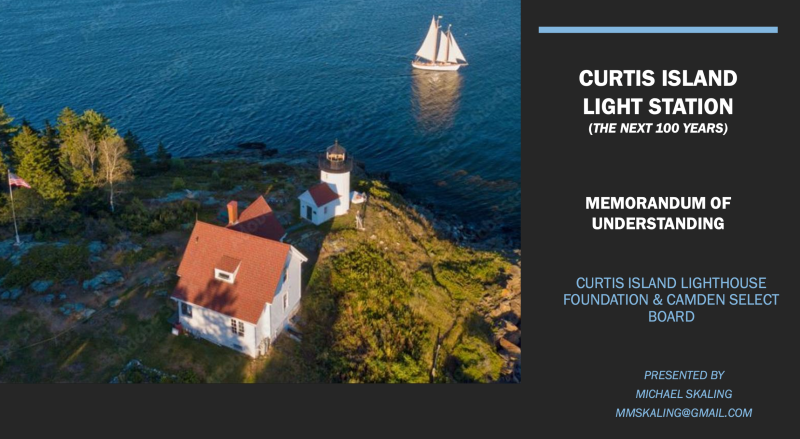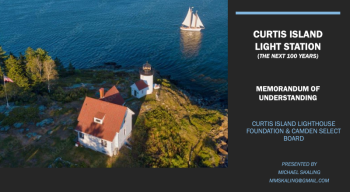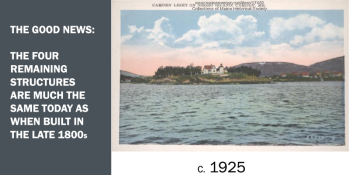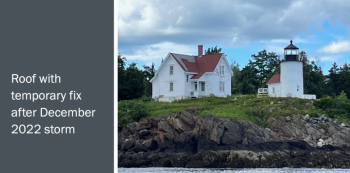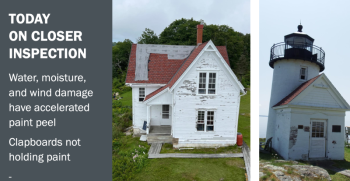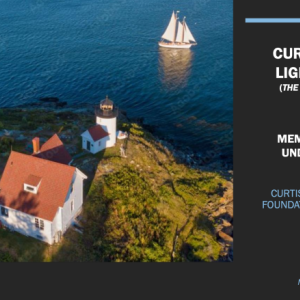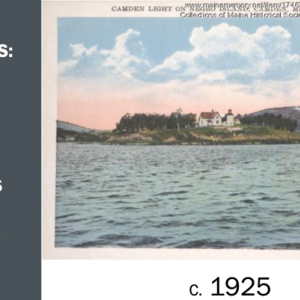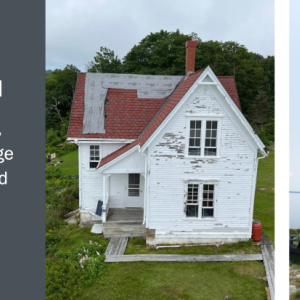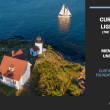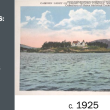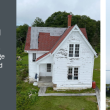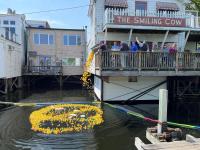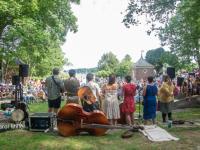Town of Camden, new foundation join forces to restore Curtis Island Light Station
The Town of Camden and a new foundation dedicated to restoring Curtis Island Lighthouse are signing a memorandum of understanding, and each will be pitching in money to fund a third-party assessment of the property, and a plan for its future.
The decision was made Dec. 5 at a regularly scheduled Select Board meeting after Camden Historic Resources Committee volunteer member Michael Skaling delivered a presentation about the iconic lighthouse and island that graces the entrance to Camden Harbor. (See attached PDF for Skaling’s presentation.)
He suggested hiring Historic Building Architects, LLC, based in Trenton, New Jersey. That firm conducted a similar assessment and plan for the Burnt Coat Harbor Light on Swan's Island. Last summer, Annabelle Radcliffe-Trenner, a principal of Historic Building Architects, visited Curtis Island.
The 5.5 acre island and its four structures, including a light tower, belongs to Camden, and it is the objective of the Curtis Island Foundation to, “provide planning, organizational, and financial resources to the Town to fully restore, maintain and preserve the Curtis Island Light Station to its historic state as it was redesigned and rebuilt in the late 1800s.”
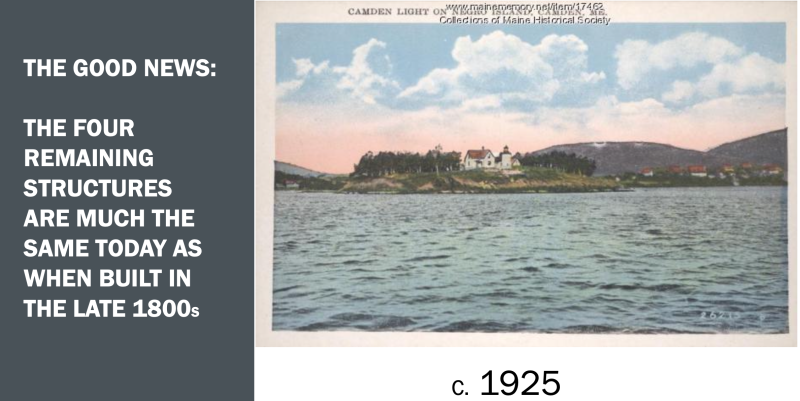
The memorandum’s terms of understanding cite the responsibility of the town to care and maintain the property, as stipulated by the U. S. Coast Guard and the Maine Historical Preservation Commission.
As of 1973, Curtis Island Lighthouse was placed on the National Register of Historic Places.
“The Curtis Island Lighthouse has for nearly 150 years served the people who have eked a livelihood from the sea as a beacon of friendship and safety,” wrote Richard Kelly, State Historic Preservationist in 1973.
A navigational fixture for centuries, it is deeply woven into the marine history of Penobscot Bay. Camden Historian Barbara Dyer called it, “the sentinel of Camden Harbor.”
The island was originally called Negro Island; according to historians, when James Richards sailed into Camden Harbor in 1769 he decreed the island for his African cook. In 1934, the island was renamed after Camden summer resident and philanthropist Cyrus Curtis.
The light station was first equipped with a hand bell, according to Michael Skaling, in his essay Camden’s Three Fog Bells. Navigational innovations and improvements were made over the decades by the federal government and the U.S. Coast Guard, and lighthouse keepers kept the beacon lit until an automated system was installed in 1972.
“For many years, the island was a signal station for the Boston-Bangor boats, many of which stopped at Camden,” wrote Kelly, to the U.S. Dept. of the Interior National Park Service. “This small island also served as a pleasure spot for many of Camden’s residents and visitors as a favorite picnic area.”
In 1973, the lighthouse and buildings came under municipal ownership, and resident keepers were contracted by the town to care for the publicly owned island.
“One night in 1970, Camden was very fortunate to own Curtis Island as the United States was giving up all rights to it the following day,” wrote Barbara Dyer. “It took three men in town to work fast when the option to own came up and they went to Philadelphia, as a meeting was being held there the following day.
“A quick history of the Island was written that night by one of the wives and the three men flew to that meeting and received the Island for Camden. They were Clifford O’Rourke, Charles Lowe and Robert Davee. Camden Selectmen accepted a deed to Curtis Island on September 24, 1973.”
Dyer, who died in 2022, called Curtis Island, “one of the prettiest spots on earth.”
Just off of Dillingham Point, the island is close to the mainland yet it is not easily accessible. A former dock on the island disintegrated decades ago, and unless one swims, rows a skiff or paddles a canoe or kayak and then scrambles ashore over seaweed covered rocks, it is beyond the ability of the public to get there.
More recently, the stewardship of the Conover family came to an end after 40 years, putting the island and its buildings back under municipal attention. Conversations began on the Historic Resources Committee and in the planning office about next steps.
The good news, according to Skaling, is that, “the four remaining structures are much the same today as when they were built in the late 1800s.”
They have strong bones and the light station remains a guiding light into Camden Harbor.
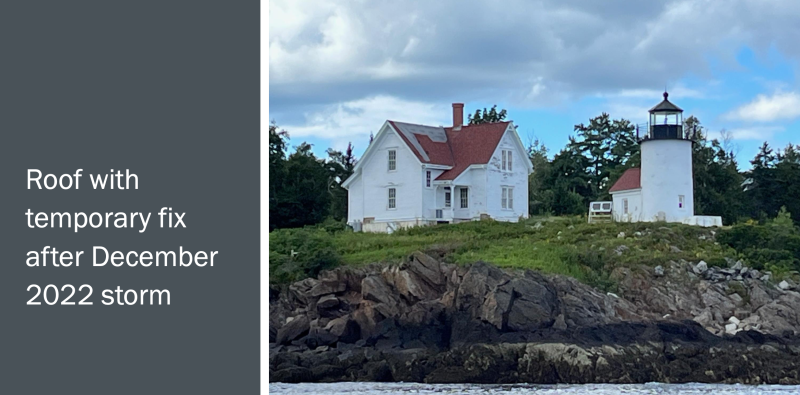
But last summer, when the town was readying to paint the exterior, crews discovered dry rot in the sills hiding beneath the clapboards, and general deterioration.

The Foundation is hoping the private consultants will help produce a refined rehabilitation/restoration plan. The vision, said Skaling, is to preserve, restore and protect Curtis Light Station for current and future generations.
“We’re thinking for the next 100 years,” he told the Select Board.

The Foundation, overseen by a board that includes Skaling, John Healy and Sam Appleton, along with advisors Philip Conkling and Jack Sanford, will raise money to help restore the buildings, and design and build access structures that were in place in the early 1900s.
The memorandum states that the initial $50,000 for the consultants to begin the assessment will be procured by Feb. 1. Then, the two entities — public and private — are to, “work cooperatively with each other” to further the restoration and maintenance goals.
While the Foundation is to raise money and process donations, the Foundation and the town will both submit grant applications to various entities.
“We know there are grants out and having a conditions report will be foundational piece for that,” said Skaling. It will, “open a lot of doors.”
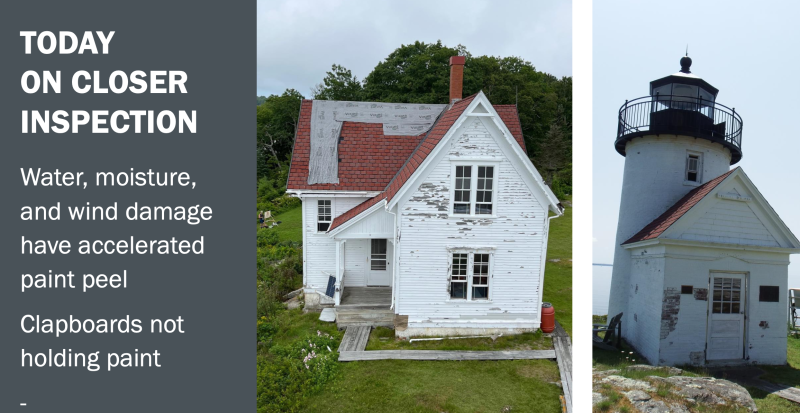
The bridge between the foundation and the town will be the Historic Resources Committee. In addition to restoring the buildings, the plan is to determine management of the island, “to whatever comes next,” said Skaling.
He suggested a project timeline of three to five years.
“We want to fast forward this so not a piecemeal approach,” said Skaling.
Camden’s Select Board favored the partnership but wanted more details about proposals.
Camden Town Planner Jeremy Martin said he had visited the island, and encouraged forward momentum with the Foundation.
“I think this is ultimately what needs to happen,” he said. Curtis Island is, “a treasured resource and we do have an obligation from when the Coast Guard handed it over to us.”
“It is a beautiful place and we’re looking forward to working with you,” said Skaling.
After listening to the conversation Dec. 5, Camden resident Silvio Calabi told the Camden Select Board: “As somebody who sails into the harbor every few days all summer long, I think it is important to fix up the lighthouse. This is the gateway to Camden, the jewel of the Midcoast. Every sailor worldwide knows Camden. And the first time you sail into our harbor, you see this patchwork on the roof and the paint peeling off. It doesn’t look good.”
With that, the conversation at the Dec. 5 board meeting concluded, followed by a unanimous vote to approve the memorandum of understanding, and a commitment to start the process of procuring an assessment.
Reach Editorial Director Lynda Clancy at lyndaclancy@penbaypilot.com; 207-706-6657

